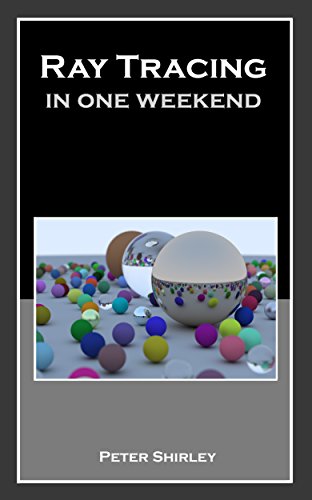- "make-web.py" and "run-web.py", http://localhost:8080/bin/web/rtow.html
https://blockulator.github.io/rtow/
- "make-win.bat" generates Visual Studio project in bin directory.
Upstream backend currently has issues so use fastcomp.
./emsdk install 1.38.45-fastcomp
./emsdk activate 1.38.45-fastcomp
- Progressive scan rendering.
- Concurrency, scanline per thread.
The Ray Tracing in One Weekend series of books are now available to the public for free in PDF form, along with the accompanying source code. Releases are available directly from GitHub, or from Eric Haine's Real-Time Rendering site. Alternatively, you can purchase the Kindle version of this series from Amazon.com. Half of the proceeds of these sales go to Hack the Hood, a really neat organization.
I’ve taught many graphics classes over the years. Often I do them in ray tracing, because you are forced to write all the code but you can still get cool images with no API. I decided to adapt my course notes into a how-to, to get you to a cool program as quickly as possible. It will not be a full-featured ray tracer, but it does have the indirect lighting which has made ray tracing a staple in movies. Follow these steps, and the architecture of the ray tracer you produce will be good for extending to a more extensive ray tracer if you get excited and want to pursue that.
When somebody says “ray tracing” it could mean many things. What I am going to describe is technically a path tracer, and a fairly general one. While the code will be pretty simple (let the computer do the work!) I think you’ll be very happy with the images you can make.
I’ll take you through writing a ray tracer in the order I do it, along with some debugging tips. By the end, you will have a ray tracer that produces some great images. You should be able to do this in a weekend. If you take longer, don’t worry about it. I use C++ as the driving language, but you don’t need to. However, I suggest you do, because it’s fast, portable, and most production movie and video game renderers are written in C++. Note that I avoid most “modern features” of C++, but inheritance and operator overloading are too useful for ray tracers to pass on. I do not provide the code online, but the code is real and I show all of it except for a few straightforward operators in the vec3 class. I am a big believer in typing in code to learn it, but when code is available I use it, so I only practice what I preach when the code is not available. So don’t ask!
I have left that last part in because it is funny what a 180 I have done. Several readers ended up with subtle errors that were helped when we compared code. So please do type in the code, but if you want to look at mine, here it is.
If you spot errors or have suggested corrections, please submit issues via GitHub.
